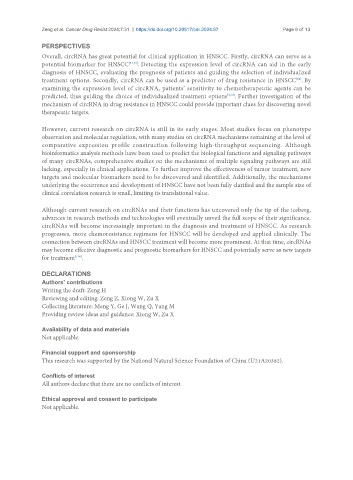Page 85 - Read Online
P. 85
Zeng et al. Cancer Drug Resist 2024;7:31 https://dx.doi.org/10.20517/cdr.2024.57 Page 9 of 13
PERSPECTIVES
Overall, circRNA has great potential for clinical application in HNSCC. Firstly, circRNA can serve as a
potential biomarker for HNSCC [51,72] . Detecting the expression level of circRNA can aid in the early
diagnosis of HNSCC, evaluating the prognosis of patients and guiding the selection of individualized
[68]
treatment options. Secondly, circRNA can be used as a predictor of drug resistance in HNSCC . By
examining the expression level of circRNA, patients’ sensitivity to chemotherapeutic agents can be
predicted, thus guiding the choice of individualized treatment options [9,18] . Further investigation of the
mechanism of circRNA in drug resistance in HNSCC could provide important clues for discovering novel
therapeutic targets.
However, current research on circRNA is still in its early stages. Most studies focus on phenotype
observation and molecular regulation, with many studies on circRNA mechanisms remaining at the level of
comparative expression profile construction following high-throughput sequencing. Although
bioinformatics analysis methods have been used to predict the biological functions and signaling pathways
of many circRNAs, comprehensive studies on the mechanisms of multiple signaling pathways are still
lacking, especially in clinical applications. To further improve the effectiveness of tumor treatment, new
targets and molecular biomarkers need to be discovered and identified. Additionally, the mechanisms
underlying the occurrence and development of HNSCC have not been fully clarified and the sample size of
clinical correlation research is small, limiting its translational value.
Although current research on circRNAs and their functions has uncovered only the tip of the iceberg,
advances in research methods and technologies will eventually unveil the full scope of their significance.
circRNAs will become increasingly important in the diagnosis and treatment of HNSCC. As research
progresses, more chemoresistance regimens for HNSCC will be developed and applied clinically. The
connection between circRNAs and HNSCC treatment will become more prominent. At that time, circRNAs
may become effective diagnostic and prognostic biomarkers for HNSCC and potentially serve as new targets
for treatment .
[100]
DECLARATIONS
Authors’ contributions
Writing the draft: Zeng H
Reviewing and editing: Zeng Z, Xiong W, Zu X
Collecting literature: Meng Y, Ge J, Wang Q, Yang M
Providing review ideas and guidance: Xiong W, Zu X
Availability of data and materials
Not applicable.
Financial support and sponsorship
This research was supported by the National Natural Science Foundation of China (U21A20382).
Conflicts of interest
All authors declare that there are no conflicts of interest.
Ethical approval and consent to participate
Not applicable.

